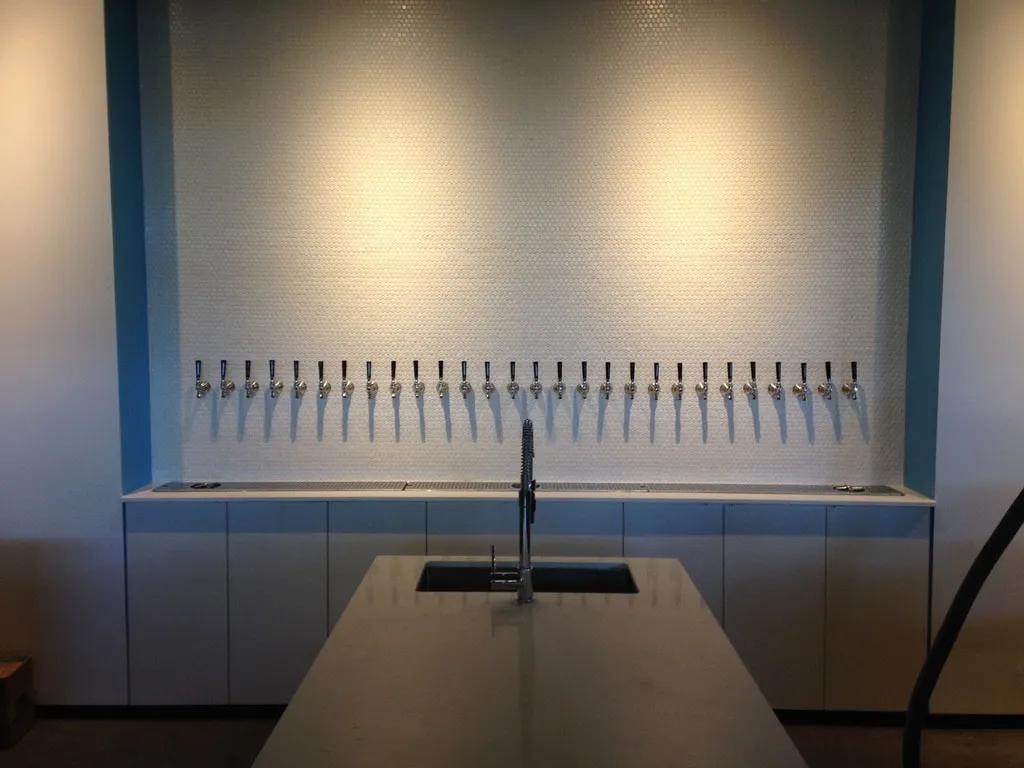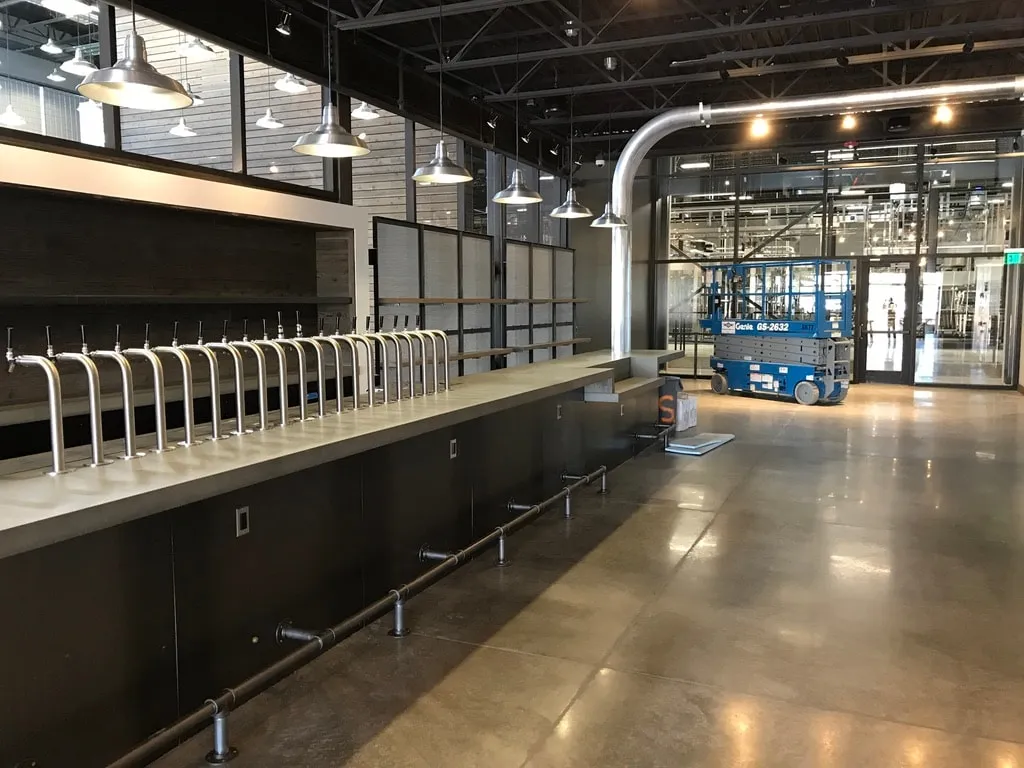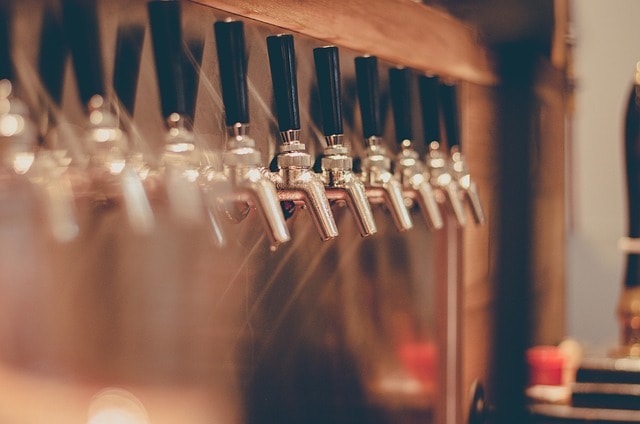6 Tap Beer Dispenser: Items to Consider For Your System

Beer tap systems are more prevalent in bars and restaurants now than they have been across the country. There are a few key components you need to be aware of. When installing or upgrading your draft beer system.
In this post, we will discuss the correct type of gas to use, the serving temperature of draft beer, keeping draft beer lines cold, the three types of beer systems, and how to protect your investment.
By the end of this post, you will have a better understanding of what it takes to serve a perfect pint—also, maintaining the longevity of your beer tap system.

Choosing The Right Type of Gas: Mixed Gas vs CO2
When it comes to gas for your draft beer system, there are two main options: mixed gas or Co2. So which is the right type of gas for you? Well, it depends on a few factors, including the type of beer you are serving, and the type of beer system you will be using. Mixed gas is a blend of CO2 and nitrogen, while CO2 is just carbon dioxide. Remember, there are different blends for different beers, and blends are used to push beer longer distances. 70/30, 75/25 and Guinness gas 25/75 Co2 to Nitro.
Check out this post for more information regarding blended gas for dispensing beer.
So why use mixed gas? Well, it’s ideal for most types of beer. Nitrogen also helps keep beer in solution. While increased pressure is needed for longer beer runs without over-carbonating the beer. A blended gas of 70 percent C02, 30 percent Nitrogen set at 22 PSI. It's probably the go-to blended gas you can use on remote systems or direct draw systems. Mixed gas also helps a beer system if you are walking in and out of a cooler all the time. The temperature fluctuations will hamper a CO2-driven system.
CO2 is an ideal gas for short direct draw systems, such as kegerators and wall-mounted beer systems hanging off a beer walk-in. These systems are designed to efficiently dispense beer directly from kegs, ensuring that the beer remains fresh and adequately carbonated.
Serving Temperature of a Beer Tap System
The recommended serving temperature for draft beer varies depending on the type. Lagers and light beers are served cold, between 36 and 38 degrees Fahrenheit. Ales and stouts are served a bit warmer, between 40 and 42 degrees Fahrenheit. It is essential to keep in mind that the temperature of the beer will rise as it travels from the keg to the tap, so you will want to adjust the temperature accordingly.

One way to keep your draft beer at the perfect serving temperature is to use a glycol chiller if you are on a remote beer system. Glycol is a type of food-grade antifreeze that can be used to keep your beer lines and taps cold. This is an excellent option if you want to serve a variety of different types of beer.
Keeping Draft Beer Lines Cold
One of the most critical factors in ensuring that your draft beer tastes great is keeping the lines cold. Draft beer lines should be kept at 38 degrees Fahrenheit at all times. If they are not, the beer will start to act funny. If it's too warm, we will get a lot of foam pouring from the beer faucet. If it's too cold there won't be much flavor in the beer.
One way to keep your lines cold is to use a glycol chiller, as we discussed earlier. Another option is to use an air-cooled draft beer system. This type of system uses fans to circulate cold air around the beer lines, keeping them at a consistent temperature.

Beer Line and Fitting Selection
When selecting beer lines and fittings for your draft beer tower, several factors must be considered to ensure optimal performance and beer quality. The type of beer line material, length, and diameter can all impact the quality of the beer being dispensed.
First, consider the beer line material. High-quality materials such as stainless steel or PVC are ideal choices. Stainless steel is particularly favored for its resistance to corrosion and durability, making it a reliable option for frequent use. PVC lines are also a good choice due to their flexibility and ease of cleaning.
Next, the length of the beer line is crucial. The distance between the keg and the faucet will determine the required length. It’s essential to choose a beer line that is long enough to reach from the keg to the faucet without kinking or bending, as this can affect the flow and quality of the beer.
Another key consideration is the diameter of the beer line. Different types of beer may require different diameters. For instance, high-flow beers might need a larger diameter to ensure a smooth pour without excessive foam.
Fittings are equally important. Ensure that you select fittings compatible with your beer lines and faucets. Hex nuts and mounting hardware are commonly used to secure beer lines to faucets and towers, providing a stable and leak-free connection.
By carefully selecting the right beer lines and fittings, you can ensure that your draft beer system operates efficiently and delivers high-quality beer every time.
Draft Beer Tower Design
A well-designed draft beer tower is essential for dispensing high-quality beer and enhancing the overall bar experience. Here are some key considerations when designing a draft beer tower:
Material is a primary factor. Opt for towers made from high-quality materials such as stainless steel. Stainless steel towers are not only durable and resistant to corrosion but also easy to clean, ensuring that your beer remains uncontaminated and fresh.
Another important aspect is the size of the tower. The number of faucets and the type of beer being dispensed will determine the appropriate size. For instance, a tower-six-tap system might be necessary for bars that offer a variety of beers, allowing multiple beers to be dispensed simultaneously.
Cooling systems play a crucial role in maintaining the optimal serving temperature of the beer. Consider a tower with an air-cooled system, which uses fans to circulate cold air around the beer lines, keeping them consistently chilled.
Faucet placement is also vital for ease of use. Place faucets at a comfortable height and distance from the counter to make it easy for bartenders to pour beer efficiently. This not only improves service speed but also reduces the risk of spills and waste.
By focusing on these design elements, you can create a draft beer tower that not only looks great but also functions flawlessly, ensuring a perfect pour every time.
3 Types of Beer Tap Systems
There are three main types of beer systems: direct draw, remote system, and air-cooled.
Direct Draw The most common type of beer system is a direct draw system. It is simple and uses a CO2 tank to push the beer from the keg to the tap. This system is ideal for home kegerators and small bars with wall-mount towers. By filling your kegerator with a variety of kegs, you can offer multiple beer options while maintaining optimal freshness and temperature.

Remote System A remote system is a more sophisticated system that uses blended gas to push the beer from the keg cooler to the beer taps. This type of system is ideal for larger bars and restaurants that need to pour beer at locations other than the beer cooler.

Air-Cooled System An air-cooled system is similar to a remote system, but it uses fans to circulate cold air around the beer lines. This keeps them at a consistent temperature. This type of system is ideal for bars and restaurants that want to serve a variety of different kinds of beer, close to a cooler.

Installation and Maintenance Considerations
Proper installation and maintenance are crucial for ensuring that your draft beer tower operates efficiently and effectively. Here are some key considerations:
During installation, it’s essential to follow the manufacturer’s instructions meticulously. Ensure that all connections are secure and that the tower is level. This will prevent leaks and ensure a smooth flow of beer from the keg to the faucet.
Maintenance is equally important. Regularly clean and sanitize the tower, faucets, and beer lines to prevent contamination and spoilage. This includes routine cleaning of beer lines every two weeks and a thorough acid clean once a quarter. Regular maintenance not only keeps the beer tasting tremendous but also extends the lifespan of your equipment.
Troubleshooting is another aspect to consider. Keep a troubleshooting guide handy to quickly identify and resolve any issues that may arise. This can include common problems like foamy beer, off-tasting beer, or inconsistent pours.
Upkeep involves regularly inspecting the tower and beer lines for signs of wear and tear. Replace any damaged or worn-out parts promptly to ensure that the tower continues to operate efficiently. This proactive approach can prevent minor issues from becoming major problems.
By paying attention to installation and maintenance, you can protect your investment and ensure that your draft beer system continues to deliver high-quality beer, maximizing your profits and customer satisfaction.
Additional Draft Quality Factors
When serving draft beer, keep a few additional factors in mind. Draft beer should always be poured into a glass, and bartenders should know how to pour it properly.
Draft beer should also be served with a head. The head gives the beer its flavor and aroma, so you want to make sure that you pour enough into each glass—3/4" -1" is ideal.
Cleanliness is also an important factor to consider when using a draft beer system. Draft beer lines should be cleaned. This will help prevent high pour costs and ensure that your beer tastes great every time you pour it. According to the Brewers Association, beer cleaning should be done every two weeks.

Use stainless steel dispensing equipment. This includes your beer faucets, shanks, and couplers. The investment will be worth it and your beer system will last a long time.
Protect Your Investment and Maximize Your Profits
Beer is a food product susceptible to contamination from various organisms. Nonetheless, anything that touches beer needs to be cleaned regularly.
Lines should be cleaned every two weeks. The recirculation method with pumps is 80 times more effective than static cleaning. Beer equipment should be scrubbed clean after soaking in a 2-3 percent caustic solution.
Acid clean your beer system once a quarter. Disassemble and clean all other beer equipment as well. If you want a great-pouring system, you need to take care of it regularly.



